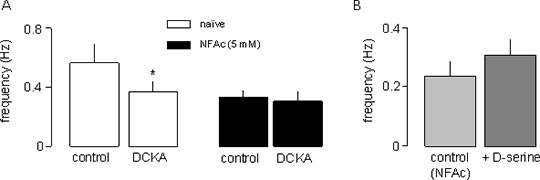Astrocytic D-serine is the co-agonist for presynaptic NMDA receptors in the rat entorhinal cortex At glutamate synapses, presynaptic NMDA receptors (preNMDAr) exert a tonic facilitatory effect on glutamate release and, thus, mediate an instantaneous form of synaptic plasticity. We first demonstrated this functional facilitatory effect at synapses in the rat entorhinal cortex (EC; 1). NMDAr activation requires binding of two agonists, a glutamate binding site located on the GluN2 subunit and a co-agonist binding site on the GluN1 subunits. Both glycine and D-serine are available as physiological ligands for the co-agonist site, but we have established that D-serine is likely to be the endogenous co-agonist at the preNMDAr (2). The source of the endogenous D-serine that binds to the preNMDAr is unknown, and in the current study we investigated the possibility that it may be released from astrocytes. In slices of rat EC, we made whole cell patch clamp recordings (in the presence of TTX, and with postsynaptic NMDAr blocked by including MK801 in the patch pipette solution) of AMPA receptor mediated miniature excitatory currents (sEPSCs) as a reporter of presynaptic glutamate release in layer V neurones. We compared mEPSC frequency and amplitude in slices with and without preincubation with the glia-specific metabolic inhibitor, sodium fluroroacetate (NFAc). In 6 neurones recorded in untreated slices (one slice from each of 6 animals), mean (±SEM) mEPSC frequency was 0.56 ± 0.13 Hz and mean amplitude was 7.6±0.9 pA. In these slices, the NMDAr co-agonist site antagonist, 5,7-dichlorokynurenic acid (DCKA) decreased the frequency of mEPSCs (Fig 1A) without change in amplitude (8.0±0.6 pA) showing that the co-agonist site of the preNMDAr was tonically activated (2). In the matched recordings from slices incubated with NFAc (n=6 from 6 animals), mEPSC frequency was considerably lower at 0.33±0.04 Hz (Fig. 1A; amplitude 7.2±0.5 pA) suggesting that astrocytes are instrumental in tonic regulation of the preNMDAr. Application of DCKA in the presence of NFAc had no further effect on mEPSC frequency (Fig 1A) or amplitude (7.4±0.8 pA). Finally, application of D-serine in the presence of NFAc partially rescued the frequency decrease induced by the latter (Fig. 1B; n=4). 
The results suggest that D-serine, released from astrocytes, activates the co-agonist site of the preNMDAr, permitting it to tonically facilitate the release of glutamate at EC synapses. (1) Berretta N and Jones RSG (1996) Neuroscience 79:339-344 (2) Lench A, Massey, PV, Pollegioni, L, Woodhall, GL and Jones, RSG, Neuropharmacology (submitted)
|


